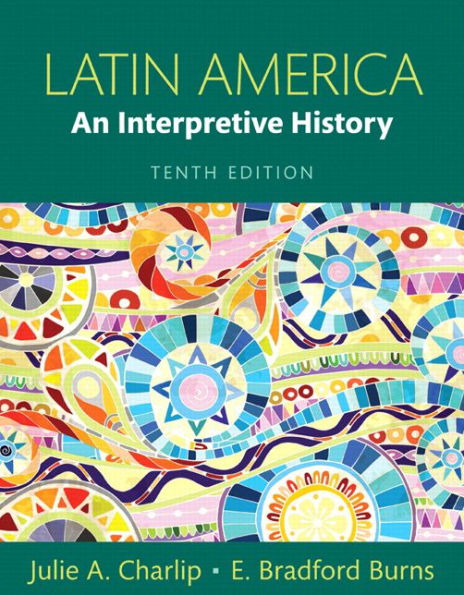Latin America: An Interpretive History / Edition 10
For courses in the History of Latin America and Modern Latin America.
A thoroughly updated examination of Latin American
Latin America: An Interpretive History interweaves the story of Latin America with coverage of broader themes and regional differences. Building upon the work of original author E. Bradford Burns, current author Julie Charlip presents Latin American history as a continuum to help students make connections among time periods and events, and see the impact of the past upon the present. A new closing chapter examines in detail the “Pink Tide”–the swing left in Latin America that began at the end of the twentieth century and has continued over the last 15 years.
NOTE: This ISBN is for a Pearson Books a la Carte edition: a convenient, three-hole-punched, loose-leaf text. In addition to the flexibility offered by this format, Books a la Carte editions offer students great value, as they cost significantly less than a bound textbook.
1124174081
A thoroughly updated examination of Latin American
Latin America: An Interpretive History interweaves the story of Latin America with coverage of broader themes and regional differences. Building upon the work of original author E. Bradford Burns, current author Julie Charlip presents Latin American history as a continuum to help students make connections among time periods and events, and see the impact of the past upon the present. A new closing chapter examines in detail the “Pink Tide”–the swing left in Latin America that began at the end of the twentieth century and has continued over the last 15 years.
NOTE: This ISBN is for a Pearson Books a la Carte edition: a convenient, three-hole-punched, loose-leaf text. In addition to the flexibility offered by this format, Books a la Carte editions offer students great value, as they cost significantly less than a bound textbook.
Latin America: An Interpretive History / Edition 10
For courses in the History of Latin America and Modern Latin America.
A thoroughly updated examination of Latin American
Latin America: An Interpretive History interweaves the story of Latin America with coverage of broader themes and regional differences. Building upon the work of original author E. Bradford Burns, current author Julie Charlip presents Latin American history as a continuum to help students make connections among time periods and events, and see the impact of the past upon the present. A new closing chapter examines in detail the “Pink Tide”–the swing left in Latin America that began at the end of the twentieth century and has continued over the last 15 years.
NOTE: This ISBN is for a Pearson Books a la Carte edition: a convenient, three-hole-punched, loose-leaf text. In addition to the flexibility offered by this format, Books a la Carte editions offer students great value, as they cost significantly less than a bound textbook.
A thoroughly updated examination of Latin American
Latin America: An Interpretive History interweaves the story of Latin America with coverage of broader themes and regional differences. Building upon the work of original author E. Bradford Burns, current author Julie Charlip presents Latin American history as a continuum to help students make connections among time periods and events, and see the impact of the past upon the present. A new closing chapter examines in detail the “Pink Tide”–the swing left in Latin America that began at the end of the twentieth century and has continued over the last 15 years.
NOTE: This ISBN is for a Pearson Books a la Carte edition: a convenient, three-hole-punched, loose-leaf text. In addition to the flexibility offered by this format, Books a la Carte editions offer students great value, as they cost significantly less than a bound textbook.
141.84
In Stock
5
1

Latin America: An Interpretive History / Edition 10
384
Latin America: An Interpretive History / Edition 10
384(10th ed.)
$141.84
141.84
In Stock

Product Details
| ISBN-13: | 9780205982264 |
|---|---|
| Publisher: | Pearson Education |
| Publication date: | 01/20/2016 |
| Edition description: | 10th ed. |
| Pages: | 384 |
| Product dimensions: | 7.10(w) x 9.00(h) x 0.50(d) |
From the B&N Reads Blog
